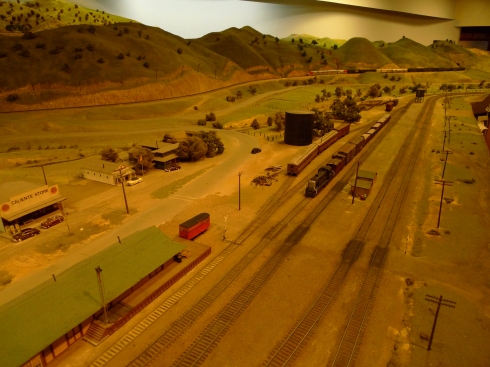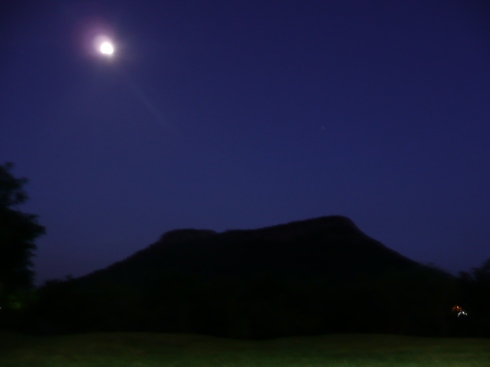My whole journey with the Paraguari train station has been one of learning– who knew there was so much to know about trains! One area I was sure I knew nothing about was model railroading. Luckily, my friend Amy (a fellow Peace Corps volunteer) has a dad who was willing to help satisfy our curiosity about the many individuals and groups that dedicate themselves to model railroading.
The model train community is made up of those that have one thing in common – a love of trains! This love could come from exposure at an early age from a parent or relative or may just be the result of an encounter that piqued an interest that lasted. In my case, it was a childhood experience that lasted most of my life now. My dad introduced me to model railroading when I was around five years old. He built me my first layout, and I got to run the train under his close supervision. This is what got me hooked to this day.

A local freight switches the town of Caliente, while a Santa Fe Passenger train drifts downgrade into town to pass. This is also part of the huge La Mesa Model Railroad Club in 1/87 scale (HO Gauge) layout circa 1952. The club models the Tehachapi Loop area of California. The club is in located near San Diego, CA USA.
Model railroading involves many skill sets and activities. These include research, modeling activities, layout construction, electronic construction/programming and operation. The research activities include prototype research of a place and time and particular location of interest. The Internet, libraries, books, magazines and historical societies are the usual sources of this information. The model construction activities involve model or kit acquisition, model building, modifications and upgrades, some final painting, lettering and weathering to enhance realistic appearance and display or storage for future use.
The layout construction activities involve building a series of realistic scenes to run the trains through. This may be a home-built layout, a club layout or a modular layout made up of small modules joined together to form a portable layout. Layout construction typically involves building bench work, tracks, bridges, buildings, scenery, towns, highways and backdrops. Layouts may be single level or multi-level and may involve some form of helix of track to connect multiple layout layers in order to lengthen the operating distance of the entire arrangement. Electronic construction involves installing the wiring to the layout or module tracks to allow the train to move either under analog or more typically under digital control. If digitally controlled, software programming is usually necessary to provide each engine with a unique address and custom operating parameters. If the layout has signals, these also have to be wired and either controlled by computer software or by preprogrammed circuit boards.

Once the layout tracks are completed and wired, and enough models are completed to operate a train, the layout is said to be operable and operating activities become possible. With operation, you can either run trains any way you want, or you can try to operate them in some prototypical manner, or you can do something in between. Determining this prototypical manner is a research activity in itself and can be an enjoyable endeavor by itself.
The hobby usually involves joining a model railroad club as a first step. Clubs usually offer a large layout and many members to interact and learn from. They may also offer the opportunity to construct all or part of a layout and get an exposure to any Model railroading activities you want to pursue. If the interest continues and grows this may lead one to build his or her own layout to operate the model trains on. Like clubs, these home layouts become social gatherings for layout construction and operation. Frequently, groups of these layout owners will band together to form construction and/or operating groups that take turns visiting each other’s layout with the objective of either helping construct or operate each other’s layouts. Some solitary people like to do build their basement or spare room empires in private and by themselves. They may invite other modelers over to help operate a medium to large-size layout because operation on these typically requires 6-25 people.

Modern box car in 1/87 scale with lettering and weathering to match prototype photo.
Modelers who lack a layout space may prefer modular layouts where you build a small standardized modeling module that is part of a larger portable operating layout. Everyone brings their standardized modules together to assemble into an operating layout that can be set up wherever space permits. If one attends a railroad show at some local mall or exposition center, you will typically see these modular layouts in action.
The main purpose of model railroading varies by the level of interest and dedication. In my own case, it is a means to meet people with a common interest and spend time operating a high quality, miniature version of a railroad in a prototypical fashion. For others, it is meant to learn the many skills involved in making operating models and then making a layout to operate them on.
Greg Henschen is a lifelong train enthusiast who enjoys prototype research, model building, decoder programming and model operation. He also enjoys layout construction, electrical wiring and track laying, but doesn’t currently get to do much of that due to a lack of layout space.
Thanks, Greg for sharing your insights into the model railroading community in the United States! The thing that surprised me the most was that it can take 6-25 people to operate a layout! What surprised you, dear readers?
Don’t forget about my current favorite train station! https://donate.peacecorps.gov/index.cfm?shell=donate.contribute.projDetail&projdesc=13-526-009
Tags: model railroading, paraguari, paraguay, peace corps partnership grant, united states





